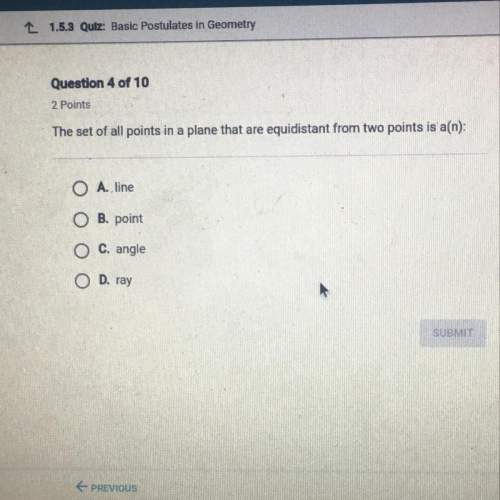
Mathematics, 25.06.2019 08:30 maddie7155
Given: a ∥ b and ∠1 ≅ ∠3 prove: e ∥ f we know that angle 1 is congruent to angle 3 and that line a is parallel to line b because they are given. we see that by the alternate exterior angles theorem. therefore, angle 2 is congruent to angle 3 by the transitive property. so, we can conclude that lines e and f are parallel by the converse alternate exterior angles theorem. which information is missing in the paragraph proof? ∠2 ≅ ∠4 ∠1 ≅ ∠2 ∠2 ≅ ∠3 ∠1 ≅ ∠4

Answers: 2


Another question on Mathematics

Mathematics, 21.06.2019 16:20
Consider the function y = f(x)=3^x the values of f(1/2) and f(1/4). rounded to the nearest hundredth, are__and__ respectively
Answers: 3

Mathematics, 21.06.2019 20:00
Need ! the total ticket sales for a high school basketball game were $2,260. the ticket price for students were $2.25 less than the adult ticket price. the number of adult tickets sold was 230, and the number of student tickets sold was 180. what was the price of an adult ticket?
Answers: 1

Mathematics, 21.06.2019 21:30
Rhombus adef is inscribed into a triangle abc so that they share angle a and the vertex e lies on the side bc . what is the length of the side of the rhombus if ab=c, and ac=b.
Answers: 1

Mathematics, 21.06.2019 22:00
Find two numbers if their sum is 91 and the ratio is 6: 7?
Answers: 1
You know the right answer?
Given: a ∥ b and ∠1 ≅ ∠3 prove: e ∥ f we know that angle 1 is congruent to angle 3 and that line a...
Questions


Biology, 22.07.2019 22:30





Mathematics, 22.07.2019 22:30







Mathematics, 22.07.2019 22:30


Biology, 22.07.2019 22:30


History, 22.07.2019 22:30





